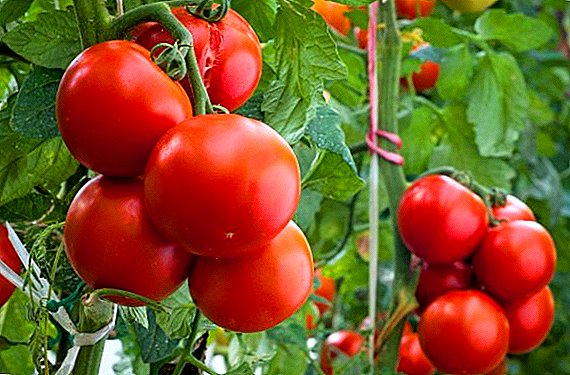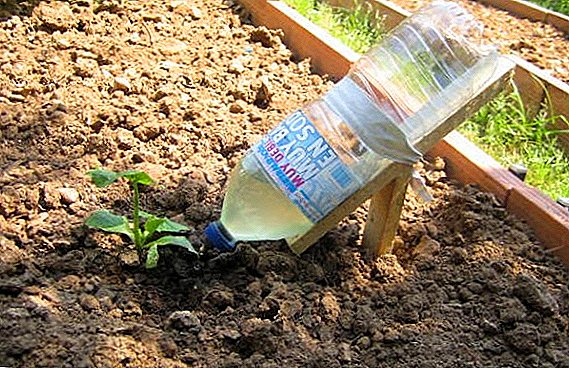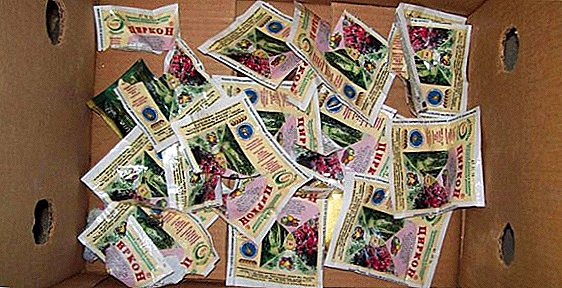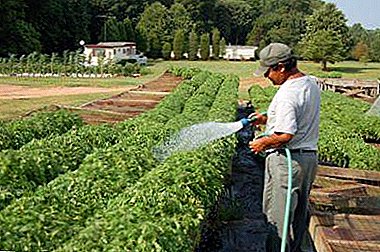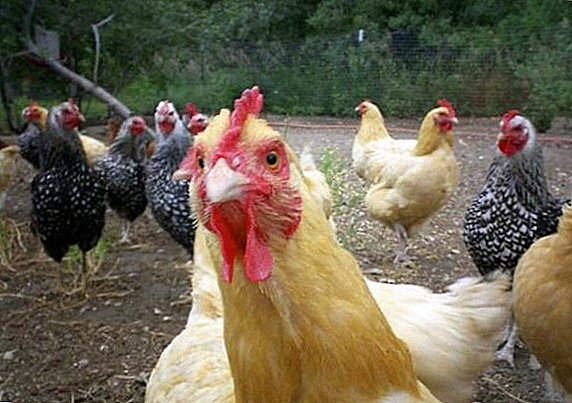 Keeping chickens in their own backyard is a simple and profitable occupation, because thanks to even a small household there will always be high-quality and environmentally friendly meat and egg products in the house. But even despite the simplicity, a novice poultry farmer without experience may have many questions regarding the organization of the process of rearing birds. The choice of breed and directly of young stock, equipment of the poultry house, the subtleties of care for small chickens and adults, preparation of a diet - these and other important aspects of the content of birds look further.
Keeping chickens in their own backyard is a simple and profitable occupation, because thanks to even a small household there will always be high-quality and environmentally friendly meat and egg products in the house. But even despite the simplicity, a novice poultry farmer without experience may have many questions regarding the organization of the process of rearing birds. The choice of breed and directly of young stock, equipment of the poultry house, the subtleties of care for small chickens and adults, preparation of a diet - these and other important aspects of the content of birds look further.
Where to buy chickens
Breeding chickens will be possible only after buying chickens. The future owners immediately have a question about where it is better to buy the chicks. There are usually several options:
- Incubatoria. This option is the best, as in the hatchery chickens hatch healthy, strong, often they are vaccinated. In addition, you can be sure that the birds are not carriers of the disease. However, the catch is that chicks are not sold at retail to the average buyer, especially in small quantities. From the hatchery chicks purchase wholesale suppliers.
- Poultry farms. This option is not the best, since in poultry farms there is a common practice of selling low-quality chickens, that is, residues after rejection. Unknowingly, people acquire such a product, moreover at a relatively low cost. However, the result of such savings can be deplorable - the livestock can be weak, unviable or, worse, infected with infectious diseases.
- Wholesale suppliers. This option is the safest and preferred. Suppliers purchasing chicks in hatcheries can deliver healthy, vaccinated, high-quality chicks to you as soon as possible.
- Markets Buying chickens on the market is comparable to playing roulette — you never know what quality the product will fall into. Chicks from private farmsteads, poultry farms, hatcheries can be represented here, prices and quality can vary significantly. Buying chickens on the market can not be sure of the right conditions for the maintenance and care of birds. But it is precisely at such a tender age that violations of care can have an extremely negative effect on the health of birds.


Thus, wholesale suppliers and hatcheries are the best option for buying chicks.
Important! A normal survival rate of 92-96% is considered, that is, out of a hundred purchased chicks should not die more than 8 individuals.The optimal age for purchase is 1-10 days from birth. The older the chicken, the higher the cost and chances of survival. With the direct selection of chickens need to evaluate them on a variety of criteria. So, first of all, chickens should look healthy. This is manifested in their activity, mobility, curiosity and sociability. Chickens in a box should squeak a little, respond well to sounds and other irritants.
Next you need to inspect the birds:
- they should have soft tummies;
- there should be no traces of umbilical cord blood;
- anal openings should be kept clean;
- fluff - dried out and even;
- Wings should be tightly pressed to the body, not lowered.
Broiler breeds may have a bluish skin tone, a looser feather and a more convex belly.
VIDEO: HOW TO CHOOSE A CHICKEN WHEN BUYING After purchasing the best way to transport the chicks is a cardboard box with holes for ventilation. If the road takes more than 3 hours, the babies need to be fed and watered.
What chickens are suitable for home breeding
It is also important to correctly determine the type and breed of birds, and it is necessary to proceed from the goals of breeding:
- Egg. This group of birds is used to produce egg products. Productivity can reach 270 eggs per year, and in modern cross-breeds - even 300 or more. The main breeds are: leggorn, minor, Russian white, broken brown, highsex, iz brown.
- Meat. This group has a much larger size and weight, stocky and strong physique, thick legs. The most popular breeds of meat in the direction: Brahma, Plymouth, broiler varieties.
- Meat-egg. Birds of this category occupy an intermediate position, their egg production is worse than that of purely egg breeds, but higher than that of representatives of the meat industry. Weight indicators and the rate of weight gain allows them to be used to obtain meat products. This group of birds is most popular for keeping in small numbers at private farmsteads, since it is unprofitable to breed them on an industrial scale from the average productivity indicators. The main breeds are Moscow White, Kyrgyz Gray, Galan, Kotlyarevskaya, Zagorskaya salmon, May Day, Yurlovskaya vociferous, Orpington, etc.
- Decorative. From the name it is obvious that the birds of this category are bred for aesthetic pleasure, participation in exhibitions and competitions, although they can also give good indicators of egg productivity (up to 100 eggs per year). Also it should be borne in mind that decorative rocks are more capricious and demanding to care. The main breeds are: bentams, Dutch white-crested, shabo, milfleur, paduan, ayam Chemni, Pavlovian chickens, phoenixes, a fireball, etc.




Chick care
After buying a young stock, they need to provide him with appropriate conditions and a diet, because in the first days of his life the chickens are most vulnerable, and the chances of death are the highest. Care may vary slightly depending on the breed, we also give the average requirements that are true for most varieties of birds chicks.
Did you know? The longest officially recorded flight of a chicken is 13 seconds.
Conditions of detention
For successful nestling, the premises must meet the following criteria:
- be dry and warm;
- no drafts;
- with high-quality ventilation;
- with the required level of humidity and lighting parameters;
- clean.
Before settling chicks, the poultry house must be disinfected with special means, washed, cleaned of physical debris, and whitened the walls. A bed of straw or sawdust is laid on the floor with a layer of 5 cm. Inside the house, you need to equip the drinkers and feeders, you also need a thermometer, heater, lamps and a hygrometer.  In the first month, while babies have poorly developed adaptability to environmental conditions, they need an elevated temperature. Populating the house can be calculated: 25-30 daily specimens per 1 square. m (egg rocks), a month later, the density is reduced to 16 goals per 1 square. m
In the first month, while babies have poorly developed adaptability to environmental conditions, they need an elevated temperature. Populating the house can be calculated: 25-30 daily specimens per 1 square. m (egg rocks), a month later, the density is reduced to 16 goals per 1 square. m
If you purchased daily babies, the thermometer mark should be at 35 ° C (the same applies to the floor temperature). For 2-3 days the temperature can be lowered to 30 ... 32 ° С. Each week, the temperature can be lowered by a few more degrees, so that by the age of one month the birds live at +21 ° C.
If you have to transport chickens, we advise you to find out what conditions need to be created for the chicks so that they can tolerate the trip well.
The humidity of the house in the first week should be in the range of 60-70%. Regarding lighting: in the first days after birth, the light is on around the clock. From the second week, the lights are turned off, starting from 15 minutes and increasing this gap so that the number of light hours is no more than 15. By the beginning of the third week, the light should work no more than 9 hours. Usually on private farms, the duration of illumination is determined by the duration of the natural daylight, since in most cases the chickens are in free-range after two weeks of age. 
Learn how to treat and prevent chickens' diseases.
Diet
The first 12-24 hours chicken without health damage can go without food thanks to the remnants of the yolk sac. Healthy chickens are usually very actively interested in food. Features of the diet of kids:
- First week. On arrival home, babies need to drink a solution of glucose (1 tsp. To 1 liter of water) to help dissolve the remnants of the yolk. Next, the chicks fed crushed boiled egg (2-3 days). Then the egg is removed from the diet, instead of it in the ration is added fat-free cottage cheese, boiled millet, corn and wheat cereals, meadow greens. The number of feedings - 8.
- Second week The diet mostly remains the same, but it is replenished with meat and bone meal and mineral feed. The percentage of grain in the diet increases. The number of feedings - 6.
- Third week. The percentage of grain increases to 50-60%, boiled potatoes are introduced. The number of feedings - 4.
- Month. The diet remains the same, the portions grow, the number of feedings - 4.
VIDEO: DIET FOOD CHIPS
Important! Starting with the 4th day of life and throughout the entire content of the bird, there should be a container with small gravel (2-3 mm) next to the feeding troughs of the babies. The chicks swallow pebbles, and they, getting into the stomach, contribute to the normal grinding of food, prevent various digestive disorders.
Conditions of detention
When young animals reach sexual age, they also need to continue to take care to get a good return in the form of high egg productivity.
Coop Requirements
Main aspects of the content:
- Dimensions. To maintain an optimal microclimate, you should not do the room above 180 cm. The parameters of the house are calculated as follows: 1 square meter. m. 5-6 individuals.
- Temperature. In summer, it is 21 ... 25 ° С above zero, in winter - not lower than + 15 ° С for good egg production.
- Humidity. At the level of 50-60%.
- Ventilation. It is optimal if the house is equipped with hoods with plugs that circulate air, but do not create drafts. If this is not possible, it is necessary to ventilate the room with the help of open air vents, but only when chickens are on the range.
- Lighting. In the chicken coop should be a window (from 10% of the floor area). For normal egg production, daylight hours should last at least 13 hours. Therefore, in winter, additional lighting with lamps (preferably red) is required.
- Litter and floor. The floor should be wooden or mud concrete, but in no case concreted. A layer of straw, hay, sawdust, grass is laid on top of a layer up to 10 cm
- Nest. Located in the corners of the poultry house at the rate of 1 nest for 5-6 cl. Usually nests are made of wooden boxes, the bottom of which is covered with straw or hay. Nests should rise at least 30 cm above the floor.
- Roosting Mandatory attribute of the house. Perches should be made of wooden poles (4-6 cm in diameter). The minimum height above the floor is 80 cm, the distance between the poles is 35-60 cm.
- Clean and disinfect. Compliance with sanitary requirements is crucial to maintaining good health and productivity of birds. Weekly you need to clean up the litter and, as it is polluted, change the litter of birds. Once a month it is necessary to treat the house with special disinfectants (“Yodoklin”, “Brovadez”, “Virotz”, etc.).
It is useful to know how to install ventilation and make lighting in the hen house.

Learn how to build a nest for laying hens.

Did you know? In Hong Kong, there is a chicken farm, Chung Hing Musical Farm, where the hens every day listen to classical, jazz, rap and pop music depending on age. According to the owner of the farm, thus in birds, productivity increases, mortality and stress levels are reduced. As a result, musical eggs are 9 times more expensive than normal! Distinguish musical products can be on the label on the eggs, which depicts a blue treble clef.
Walking yard
If possible, the walking yard should be located on the south side of the house. Its area should exceed the area of the room by 2-3 times. The territory should be protected with a grid, height - 2-2.5 m. Ideally, if the grid is also stretched from above (for example, the shading grid for plants) or the territory of the courtyard is slightly shaded by trees.
Ash baths for birds should be located on the walking yard, because they are in dire need of such bathing. Capacities can be made from planks, bath sizes: 120x70x20 cm. To fill in equal proportions, ash, clay and sand are mixed. The mixture should not get wet!  It should be borne in mind that for broiler and meat breeds the need for walking is minimal or absent altogether, but the egg varieties of the klish are in dire need of a good range. Otherwise, their egg production decreases, their health and health deteriorate.
It should be borne in mind that for broiler and meat breeds the need for walking is minimal or absent altogether, but the egg varieties of the klish are in dire need of a good range. Otherwise, their egg production decreases, their health and health deteriorate.
Feeders and drinkers
Feeders need to be placed inside the house and in the courtyard. It is convenient to equip them from wooden boards, making them narrow and oblong. The number of feeders can be calculated as follows: 1 individual requires up to 15-20 cm of space (for chicks - 2 times less). Be sure to make sure that the chickens have free access to the feeders, otherwise fights and feeding conflicts will arise with a high probability, weak individuals will be ousted and injured, even raking is possible.  Nippelny drinking bowl Basic requirements for feeders:
Nippelny drinking bowl Basic requirements for feeders:
- ease of cleaning. The material, dimensions and the design of the feeder itself should allow it to be easily arranged, maintained;
- optimal sizes for adult livestock and chickens;
- rational feed consumption. In birds, it should not be possible to climb into the trough, leave feces there, rake food. Save feed allow bumpers and turntables.

Learn how to build feeders and drinkers for chickens with their own hands.
What should take care in the winter
Here we should proceed from the characteristics of the selected breed. Different types of chickens suffer winter cooling in different ways. Some will require additional warming or heating the house. For these purposes, you can use foam and drywall (for walls), as well as infrared film, a thick layer of hay or peat (on the floor). Rocks unsuitable for cold weather cannot be let out into the courtyard at sub-zero temperatures, and even on a fine winter day for short walks, the area for walking should be covered with a layer of flooring.
It should be borne in mind that in almost all breeds, productivity decreases in winter, and during winter molting, egg production may stop for a month. During the cold spell, when the birds will spend more time inside the house, more attention will need to be paid to cleaning, disinfection and ventilation.
Important! In order to maintain egg-laying, it is imperative to arrange additional lighting so that the total duration of daylight should be at least 14 hours.
Chicken Diet
The diet of adults will be slightly different in the cold and warm season. So, in summer, when the birds are on the run, they have the opportunity to get pasture. In winter, you should take care of the enrichment of the diet. However, the exact feeding rules of the Klish are determined by the characteristics of the breed. 
In the summer
In the warm season, the basis of the diet is grain, to which large quantities of herbs and greens, juicy fresh vegetables, protein foods, meat and bone meal are added. Mineral supplements and salt are also needed. The daily rate of food per individual is 140 g. Both in summer and in winter, the chickens must be fed 4 times a day at regular intervals. The first feeding should occur very early, and the latter as late as possible. Also in the summer should pay attention to the harvesting of greens for the winter (alfalfa, nettle, chestnuts and acorns).
Read the recipe for preparing feed for poultry at home.
The approximate composition of the mash in the summer:
- 50 g of cereal mixture;
- 50 g of flour mixture;
- 30-50 g of chopped fresh vegetables;
- 10 g of green herbs;
- 10-15 g of protein;
- 5 g of mineral additives, salt.
Protein food should be of plant and animal origin. In the first case, it is sunflower meal, rapeseed meal, pulses and soybeans. The source of animal protein from fish and meat waste from the table, meat and bone meal and fish meal, dairy products (cottage cheese, yogurt, whey), small clams and amphibians, larvae and worms. 
In winter
In winter, the ration is replenished with wet mash, boiled potatoes, dairy products and meals. Wet mash must be filled with warm milk, yogurt or whey and immediately fed to the bird before the food has cooled. The daily feed rate per clutch is 120 g.
The composition of the mash on winter:
- 50 g of cereal mixture;
- 100 g of boiled potatoes;
- 10 g of herbal preparation;
- 100 g of dairy products;
- 7 g of meal;
- 5.5 grams of mineral additives and salt.
During the molting period
During this period, it is necessary to reduce the length of daylight and the brightness of the light. Many poultry farmers prefer to expose birds to artificial starvation on the water for several days immediately before the molt, and with the beginning of the molt to resume feeding. During this period, the diet should be easier, more varied and less calorie. 
Important! Under normal feeding and digestion, bird droppings will be well shaped, of a dark color with a light touch. If you deviate from this norm, you need to analyze the diet and make adjustments.
Signs of illness
Diseases of birds are divided into infectious, non-infectious, helminth infections and diseases caused by insects. In infectious diseases the following symptoms are often observed:
- lethargy, apathy, inertia of a bird;
- depression, desire to hide in a corner;
- lack of appetite, thirst can be increased;
- понос (часто каловые массы окрашены в нездоровый цвет или имеют примеси крови);
- lowered wings;
- blue scallop, earrings;
- temperature rise;
- respiratory failure;
- at the extreme stages, motor disturbances, convulsions, convulsions and paralysis may occur.
Helminthiasis can be suspected by a decrease or lack of appetite and diarrhea.
Read about how to get rid of worms in chickens.
Non-communicable diseases include avitaminosis and hypervitaminosis, food poisoning and infections resulting from injuries and traumas. With an unbalanced diet and a deficiency of vitamin and mineral substances in poultry, productivity decreases, appearance (feathers can fall out), weight decreases, the lumps weaken, and the color and consistency of feces also change.  Signs of helminthiasis in chickens When poisoning, the symptoms are very similar to those of infectious infections, but not all the livestock may suffer, and some individuals who have access to low-quality food or toxic substances.
Signs of helminthiasis in chickens When poisoning, the symptoms are very similar to those of infectious infections, but not all the livestock may suffer, and some individuals who have access to low-quality food or toxic substances.
Skin diseases have the following clinical picture:
- persistent itching (bird itches all the time);
- anxiety, excitability, and anxiety;
- polisse;
- bloody marks on the skin.
Did you know? Every year in the world consumed more than 560 billion eggs.
In order to prevent illnesses, it is necessary to buy high-quality chickens only from proven hatcheries and suppliers. It is also important to monitor the sanitary conditions, the quality of feed. Keeping chickens full, satiated, warm and dry, and regular walks help prevent most diseases.
Tips for beginners
In conclusion, we give a few recommendations:
- Decide on the purpose of keeping birds: for meat, for getting eggs, or both of them.
- To get started, buy a small batch of chickens. Thus, in case of errors in care, losses and damages will be minimal.
- If you do not have experience in breeding chickens, do not acquire capricious breeds that require special conditions of detention and care.
- If you plan to keep together 2 or more breeds of chickens, ask the breeders about the temperament of birds and their needs.
- Young animals, chickens and adults should be kept separate.
 Keeping chickens at home can be done by anyone. These feathery creatures are generally characterized by good health, survival, they are not picky, so they will be happy to recycle the leftover food from your table. Good performance indicators can be obtained even with minimal conditions and costs.
Keeping chickens at home can be done by anyone. These feathery creatures are generally characterized by good health, survival, they are not picky, so they will be happy to recycle the leftover food from your table. Good performance indicators can be obtained even with minimal conditions and costs.
Reviews




